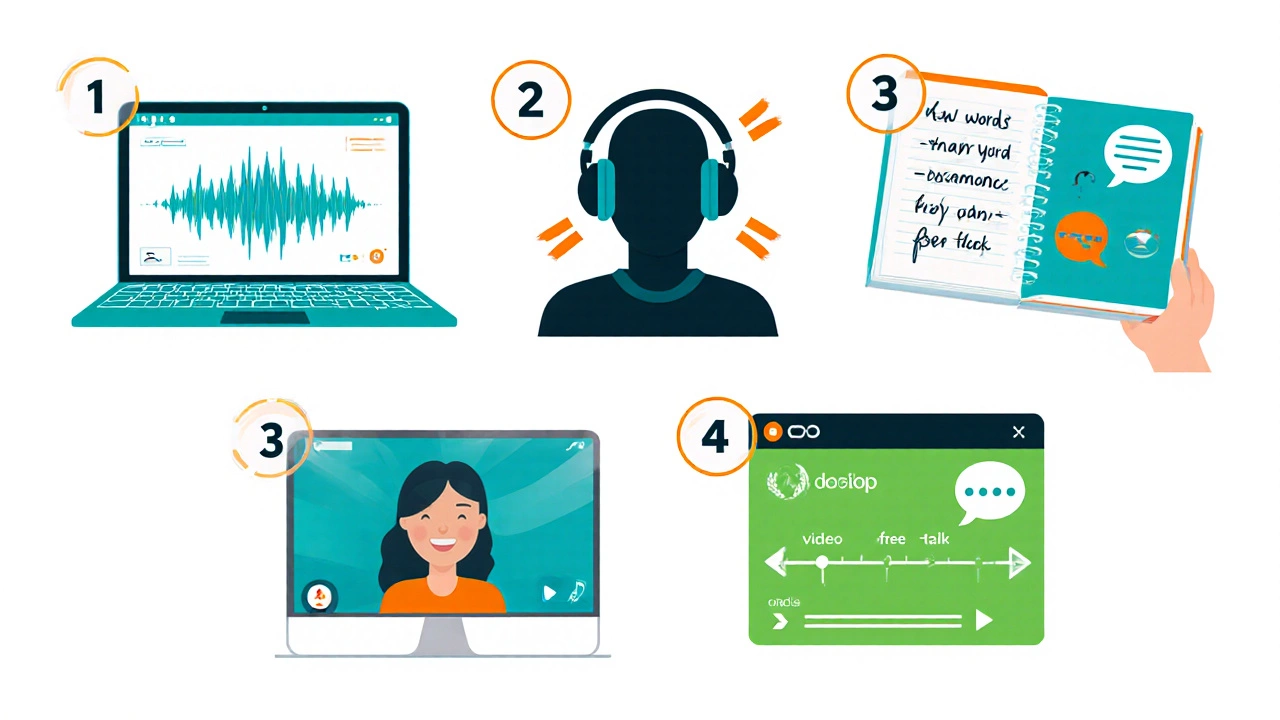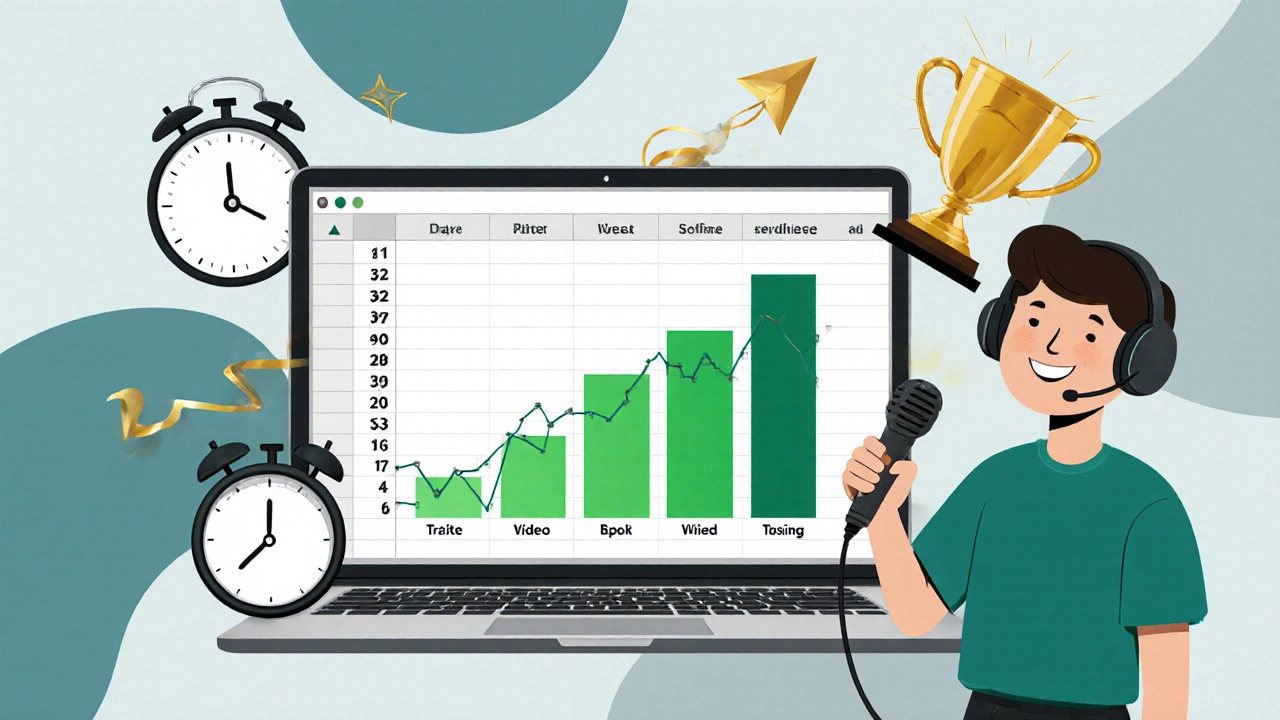Fluency Progress Estimator
English Fluency Progress Calculator
Your Fluency Timeline
Your estimated timeline includes:
- Active speaking practice 45%
- Listening comprehension 25%
- Vocabulary building 15%
- Pronunciation & grammar 15%
Your Progress Roadmap
Keep Track of Your Progress
Record your weekly speaking minutes and vocabulary usage in a simple spreadsheet to monitor your improvement.
Ever feel stuck at the "I can understand but not speak" stage? You’re not alone, and the good news is that fluency is a skill you can train, just like a sport or a musical instrument. Below you’ll find a step‑by‑step plan that blends science‑backed techniques with real‑world habits, so you can start chatting confidently in English right away.
What is English fluency?
English fluency means being able to understand, think and express ideas smoothly in English without long pauses or constant self‑correction. It’s not about perfection; it’s about communication flow. When you reach fluency, you can join a meeting, tell a story, or negotiate a deal without hunting for words.
Core language skills you must train
- Listening comprehension helps you pick up natural rhythm, intonation and new vocabulary from native speakers
- Speaking practice builds muscle memory in your mouth and trains your brain to retrieve words quickly
- Vocabulary building expands the pool of words you can draw from during conversation
- Pronunciation training sharpens clarity so listeners understand you the first time
- Grammar accuracy keeps your sentences structurally sound, avoiding misunderstandings
Daily routine that turns practice into habit
- English fluency starts with 15 minutes of active listening - podcasts, short YouTube clips, or news briefs. Pause after each segment, repeat the key sentence out loud.
- Spend 10 minutes shadowing: play the audio again and try to mimic the speaker’s speed, stress, and intonation without looking at a script.
- Write down three new words, look up their meanings, and create a mini‑sentence for each.
- Practice those sentences with a language exchange partner someone who speaks English and wants to learn your native language via video call or a local meetup.
- End the session with a 5‑minute “free talk” - talk about your day, a hobby, or a news story, ignoring mistakes. Record it, listen back, and note any recurring errors.

Effective techniques that speed up progress
Besides the routine, certain methods have proven to accelerate fluency.
- Shadowing technique forces you to reproduce native speech patterns in real time, improving rhythm and pronunciation. Use TED Talks or Netflix series with subtitles turned on.
- Speaking clubs provide a low‑pressure environment where learners rotate speaking turns on a set topic. Look for clubs on Meetup or local libraries.
- Online speaking courses offer structured lessons, instant feedback from tutors, and a community of peers. Platforms like iTalki, Cambly, or Preply let you book 30‑minute sessions on demand.
- Accent reduction focuses on problematic sounds for non‑native speakers, using visual mouth diagrams and slow‑motion video analysis. Target sounds such as /θ/ and /ð/ if they feel unnatural.
Choosing the right learning path - quick comparison
| Method | Cost (monthly) | Flexibility | Feedback speed | Best for |
|---|---|---|---|---|
| Self‑study (books, apps) | £0‑£20 | Very high | Delayed (self‑check) | Budget‑conscious learners |
| Group classes (local language schools) | £100‑£250 | Medium (fixed schedule) | Immediate (teacher) | People who enjoy peer interaction |
| Online speaking courses | £30‑£120 | High (book anytime) | Very fast (live tutor) | Busy professionals |
| Immersion (travel, work abroad) | Varies widely | Low (requires relocation) | Instant (real‑world) | Adventurous learners seeking rapid boost |
Pick the option that matches your budget, schedule, and comfort level. Many learners start with self‑study, then add a weekly online session for targeted feedback.

Common pitfalls and how to dodge them
- Focusing only on grammar. Grammar without speaking is like learning the rules of a game you never play. Pair each rule with a speaking drill.
- Waiting for perfection. Over‑editing kills momentum. Accept small errors and keep the conversation flowing.
- Skipping regular listening. Without exposure to natural speed, your brain can’t anticipate phrasing. Keep daily listening even if you feel bored.
- Isolating practice. Speaking alone is useful, but real interaction forces you to adapt. Use language exchange apps or local meetups.
Tracking progress and staying motivated
Set measurable milestones. For example, aim to deliver a 2‑minute speech on a familiar topic without using filler words. Record weekly, compare with the previous week, and celebrate improvements.
Use a simple spreadsheet with columns for date, activity, new vocab, minutes spoken, self‑rating (1‑5). Seeing the numbers rise is a powerful motivator.
Frequently Asked Questions
How long does it take to become fluent?
Time varies widely. With daily focused practice, many learners report noticeable fluency after 6‑9 months, while others may need 12‑18 months. Consistency beats intensity.
Is it better to learn British or American English?
Choose the variant that aligns with your goals. British English is useful for UK‑based work or education, while American English dominates most media. Consistency matters more than the accent you pick.
Can watching movies replace speaking practice?
Movies improve listening and vocabulary, but they don’t train the muscles needed for speaking. Pair watching with shadowing or repeating lines aloud.
How do I find a reliable language exchange partner?
Platforms like Tandem, HelloTalk, or local university bulletin boards are good starters. Look for partners with similar commitment levels and set clear expectations (e.g., 30‑minute sessions, equal language split).
Should I focus on vocabulary or phrases?
Phrases win for fluency because they embed grammar and collocation. Learn “make a reservation” before memorizing “reservation”.
